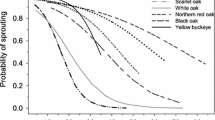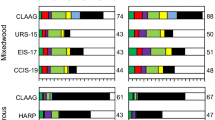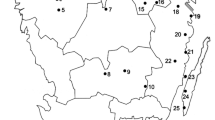Abstract
The objective of this study was to compare the survival and volume of conifer stands at 26 years of age with their status at planting. Survival, growth and damage were studied in eight clear felled stands regenerated in 1972. Five of the areas were planted with Norway spruce (Picea abies (L.) Karst.) and three with Scots pine (Pinus sylvestris L.). The plantings were examined in 1972 and 1974. In 1974, the number of living undamaged planted seedlings was low (10–15%). However, the number of undamaged seedlings was supplemented by naturally regenerated conifer and birch seedlings. The total number of undamaged seedling in 1974 was equivalent to 20–30% of the number of seedlings planted. In 1998, the main species in three stands had changed from Norway spruce to Scots pine, and in one stand from Norway spruce to birches. Actual volume in 1998 for the stands was compared to stand volume generate according to five scenarios based on recommended and actual seedling number in 1972 and 1974. The actual volume was 64% of that expected if the recommended number of trees had been planted. Naturally regenerated Scots pine and Norway spruce increased stand density in 1998. The actual volume was 37% higher than the average volume in the surrounding county. On average, 36% of the trees were damaged. More than 50% of the total damage was caused by moose (Alces alces L.). For Scots pine, moose or other browsing animals damaged 30% of the trees. The results of this study indicate that the 1998 volume was higher than expected, considering the low number of undamaged seedlings in 1974. This was mainly due to the large amount of naturally regenerated plants. In addition, the results indicate that the volume could have been higher if the initial conditions had been better. Despite the low number of undamaged seedlings in 1974, seven of the eight studied stands produced a higher volume than the average stand for the region. In practise, high numbers of seedlings should be planted on scarified areas. In most cases there will be a supply of naturally regenerated seedlings.
Similar content being viewed by others
References
Ackzell L. 1994. Forest Regeneration by Nature and Man – Studies in Boreal Sweden Emphasising Genetic Aspects. Department of Forest Genetics and Plant Physiology, Swedish University of Agricultural Sciences, Dissertation, 44 pp.
Agestam E. 1985. A Growth Simulator for Mixed Stands of PineSpruce and Birch in Sweden. Swedish University of Agricultural Sciences, Department of Forest Yield Research, Report 15, 150 pp.
Anonymous. 1988. Skogsvårdslagen. Handbok. (Forest law). National Board of Forestry, Jönköping, 115 pp. In Swedish.
Anonymous. 1998. Instruktion för fältarbetet vid riksskogstaxeringen år 1998. (Instruction for the Fieldwork at the National Forest Survey Year 1998). Department of Forest Resource Management and Geomatics, Swedish University of Agricultural Sciences, 4: 1–5: 38. In Swedish.
Anonymous. 1999. SAS/STAT Guide for Personal Computors. Version 8, 2th ed. SAS Institute Cary, NC, 846 pp.
Anonymous. 2001. Skogsstatistisk årsbok 2001. Summary: Statistical Yearbook of Forestry 2001. Official Statistics of Sweden. National Board of Forestry, Jönköping, 337 pp.
Andersson S.O. 1954. Funktioner och tabeller för kubering av småträd. Zusammenfassung: Funktionen und Tabellen zur Kubierung kleiner Bäume. Meddelande från Statens Skogsförsöksanstalt, Band 44(12), 29 pp.
Bergman F. 1971. Allmän beskrivning av dagens metoder för skogsodling, Förutsättningar för Mekaniserad skogsodling. (General Description of Methods of Today for Artificial Regeneration. Assumptions for Mechanised Regeneration.) State council for forestry and agricultural science, Section for forestry research, pp. 23–27, Swedish.
G. Bergström J. Bergquist (1997) ArticleTitleFrequencies and patterns of browsing by large herbivores on conifer seedlings Scand. J. For. Res. 12 288–294 Occurrence Handle10.1080/02827589709355412
Brandel G. 1990. Volymfunktioner för enskilda träd: tall, gran och björk. Summary: Volume functions for individual trees: Scots pine (Pinus sylvestris), Norway spruce (Picea abies) and birch (Betula pendula Betula pubescens). Swedish University of Agricultural Sciences. Department of Forest Yield Research. Report 26, 183 pp
K. Danell (1989) ArticleTitleÄlgbete på tall. I. Den biologiska orsaken. Summary: moose browsing on pines. I. The biological background K. Skogs-o. Lantb. Tidskr. 128 105–109
P. Gemmel (1988) ArticleTitleDevelopment if beeted seedlings in three Picea abies (L.) Karst. stands Scand. J. For. Res. 3 175–183
D. Hamilton (1986) ArticleTitleA logistic model of mortality in thinned and unthinned mixed conifer stands of Northern Idaho Forest Sci. 32 IssueID4 989–1000
H. Hulten (1974) ArticleTitleManuell skogsodling och aktuell metodutveckling. Summary: manual artificial regeneration and current development of methods Sveriges Skogsvårdsförbunds Tidskrift 1 176–183
Kempe G. 1990. Älgens skadegörelse i tallungskogen (The Moose Damage in Young Pine Forests). Skogsfakta, Inventering och ekonomi nr 24, 6 pp. In Swedish.
Y.J. Lee (1971) ArticleTitlePredicting mortality for even-aged stands of Lodgepole pine For. Chron. 47 29–32
Liedholm H. 1983. Resultat av skogsstyrelsens älgbetesinventering 1983 (Results of the National Board of Forestry’s Moose Grazing Inventory 1983). Skogsstyrelsen, 66 pp. In Swedish.
Lindström A. 1978. Swedish Nurseries and Plant Production. Department of Forest Yield Production, Swedish University of Agricultural Sciences. Internal Reports, 16 pp.
A. Monserud (1976) ArticleTitleSimulation of forest tree mortality Forest Sci. 22 438–444
Naumburg J. 2000. Damage and Causes of Death in Plantations with Containerised Seedlings of Scots Pine and Norway Spruce in the Central of Sweden. Department of Forest Management and Products, Swedish University of Agricultural Sciences. Report 12, 37 pp.
Näslund M. 1940. Funktioner och tabeller för kubering av stående träd. Tall, gran och björk i norra Sverige. Zusammenfassung: Funktionen und Tabellen zur Kubierung stehender Bäume. Kiefer, Fichete und Birke in Nordschweden. Meddelande från Statens Skogsförösöksanstalt, Häfte 32, pp. 87–142.
Pettersson N. 1992. Inverkan av planteringsförbandet på volym och struktur i tall- och granbestånd. Summary: The Effect of Spacing on Volume and Structure in Planted Scots Pine and Norway Spruce Stands. Department of Forest Yield Research, Swedish University of Agricultural Sciences. Report 30, 58 pp.
Tuhus E. 1997. Naturlig avgang av traer. Summary: Natural Mortality of Trees. Research Paper of Skogforsk. Norwegian Forest Research Institute. Report 6, 28 pp.
Author information
Authors and Affiliations
Corresponding author
Rights and permissions
About this article
Cite this article
Johansson, T., Naumburg, J. From planting to 26 years of age – actual growth and estimated volume scenarios for spruces and pines. New Forest 32, 163–178 (2006). https://doi.org/10.1007/s11056-005-8658-z
Received:
Accepted:
Issue Date:
DOI: https://doi.org/10.1007/s11056-005-8658-z




